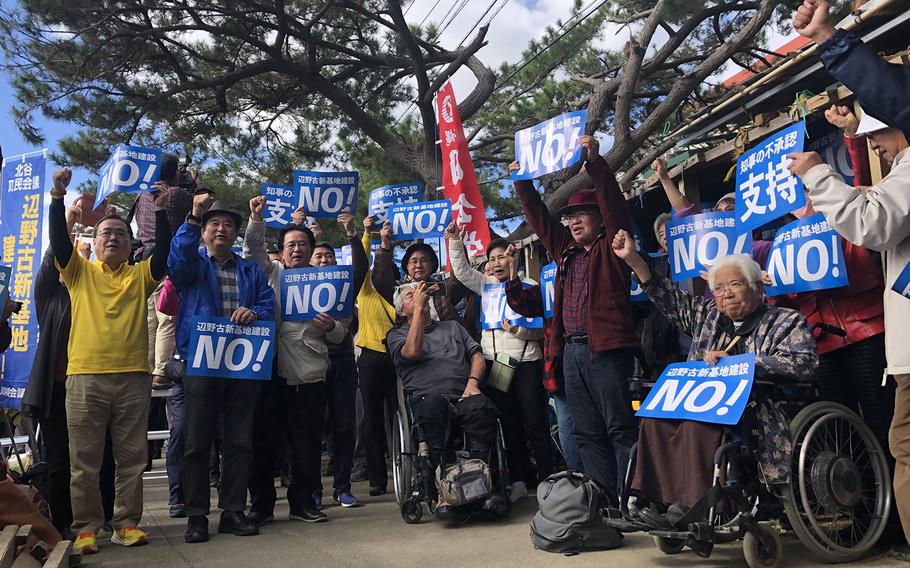
Protesters gathered outside Camp Schwab, Okinawa, Friday, Jan. 12, 2024, following the restart of construction for a runway being built into Oura Bay. (Mari Higa/Stars and Stripes)
CAMP SCHWAB, Okinawa — Close to 1,000 people gathered Friday outside this Marine Corps base to protest construction to create a military runway from reclaimed sea bottom.
Several citizens’ groups opposed to the continuing presence of U.S. military bases rallied at 10 a.m. during the protest organized by All Okinawa. About 10 speakers expressed their dissatisfaction with the Japanese government’s approval of a modified construction plan over the objections of Okinawa’s governor.
Hiroji Yamashiro, of the Okinawa Peace Activity Center, shouted through a microphone to say Tokyo is not qualified to decide the airfield question on behalf of the local government.
He also said the citizens’ effort is successfully delaying its construction.
“It is impossible to complete this base,” he said. “They won’t be able to landfill the water as deep as [328 feet], not even in 100 years.”
The runway is being built on reclaimed land in Oura Bay in the rural Henoko area to replace Marine Corps Air Station Futenma in urban, densely populated Ginowan.
Work started Wednesday on the beleaguered project after a Japanese Cabinet minister, acting on a court decision in Tokyo’s favor, approved permits for design changes blocked by Okinawa Gov. Denny Tamaki.
Tetsuo Saito, minister of land, infrastructure, transport and tourism, approved the permits on Dec. 28 after a protracted legal contest with Tamaki, who ignored a Dec. 25 court-imposed deadline to approve the permits himself.
Tamaki did not join the Friday’s protest, but a message from him was read aloud: “Now is the time to gather our strengths to stop the Henoko new base construction.”
One protester, Teruaki Shimoji, 76, of Urasoe city, said anger drove him to the demonstration.
“The anger has been piling up for years,” he said. “The Japanese government has been using Okinawa throughout history but does nothing for Okinawan people.”
Permit applications for the site have been pending since November 2021. Tamaki repeatedly refused to approve them until the Fukuoka High Court handed Saito that authority.
Tamaki has appealed the case a second time to Japan’s Supreme Court, but the Local Autonomy Act states that work may proceed while the appeal is pending.
The governor argued that the soft seabed in the construction zone poses a hazard and that Tokyo had failed to consider the environmental impact on the endangered dugong, a cousin of the manatee protected by Japanese law.
The project, originally slated for completion by 2014, will now take until at least 2032 and cost the Japanese government $6.9 billion, at last estimates.